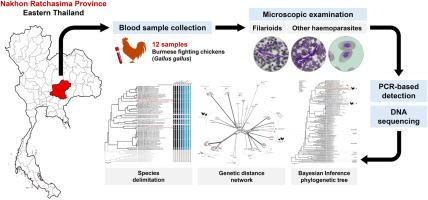缅甸斗鸡(Gallus Gallus)盘尾丝虫病科(线虫纲:丝虫科)潜在新种的发现:对禽丝虫病和近核疟原虫合并感染的遗传见解
IF 1.7
Q3 PARASITOLOGY
Current research in parasitology & vector-borne diseases
Pub Date : 2025-01-01
DOI:10.1016/j.crpvbd.2025.100303
引用次数: 0
摘要
对泰国东部那空叻差马省饲养的缅甸斗鸡(Gallus Gallus)进行了丝虫病和与其他血液寄生虫共感染的调查。显微镜和针对cox1基因的分子诊断显示,12只鸡中有2只盘尾丝虫病检测呈阳性。1只鸡携带单一感染(盘尾丝虫病科CH09),其特征是微丝蚴裸露,角质层呈交叉条纹,前端钝,头间隙短,尾尖呈钩状。另一只鸡表现出混合丝虫病感染,需要对两个不同的分离株(盘尾丝虫病科CH07-S1和CH07-S2)进行亚克隆。该鸡有两种不同的微丝虫体形态:(i)无鞘微丝虫体,类似盘尾丝虫科(Onchocercidae sp. CH09); (ii)有鞘微丝虫体,头侧空间短,两端细胞核成对。对cox1序列的遗传分析表明,这些形式属于两个不同的物种。分离株CH09和CH07-S1与泰国东部鸡盘尾虫科(Eufilaria sp.) ROE14 (GenBank: PQ564658)相似。它们在系统发育上不同于雀形目鸟类和库蚊中的其他真丝虫和丝状总科,表明它们可能是一种潜在的新型盘尾丝虫或遥远的真丝虫种。CH07-S2与来自泰国东部一只鸡的盘尾丝虫科(Onchocercidae sp.) KLS08 (GenBank: PQ564657)遗传亲和度最高。有趣的是,他们建立了一个与其他报道的寄生于鸟类宿主的丝虫属不同的分支,可能是一个新的盘尾丝虫种或属。12只鸡中6只检出近核疟原虫,其中1例与盘尾丝虫病合并感染。我们的研究强调了分子方法在揭示丝虫病多样性和遗传关系方面的重要性,同时强调了泰国及其他地区禽类丝虫病的新兴热点。本文章由计算机程序翻译,如有差异,请以英文原文为准。

Discovery of potentially novel species of the Onchocercidae (Nematoda: Filarioidea) in Burmese fighting chickens (Gallus gallus): Genetic insights into avian filariasis and co-infection with Plasmodium juxtanucleare
Burmese fighting chickens (Gallus gallus) raised in Nakhon Ratchasima Province, eastern Thailand, were investigated for filarioids and co-infection with other haemoparasites. Microscopy and molecular diagnostic targeting the cox1 gene revealed that 2 out of 12 chickens tested positive for onchocercid filarioids. One chicken carried a single infection (Onchocercidae sp. CH09), characterized by unsheathed microfilariae with a cross-striated cuticle, a blunt anterior end, a short cephalic space, and a hook-like tail tip. Another chicken exhibited a mixed filarioid infection, necessitating the subcloning of two distinct isolates (Onchocercidae sp. CH07-S1 and CH07-S2). This chicken had two distinct microfilarial forms: (i) unsheathed microfilariae resembling Onchocercidae sp. CH09 and (ii) sheathed microfilariae with a short cephalic space and paired nuclei at both extremities. Genetic analyses of cox1 sequences demonstrated that these forms belong to two distinct species. Isolates CH09 and CH07-S1 closely resembled Onchocercidae sp. (Eufilaria sp.) ROE14 (GenBank: PQ564658) derived from a chicken in eastern Thailand. They constituted a clade phylogenetically distinct from other species of Eufilaria and Filarioidea in passerine birds and Culex mosquitoes, suggesting they may represent a potentially novel onchocercid or a distant Eufilaria species. CH07-S2 exhibited the closest genetic affinity to Onchocercidae sp. KLS08 (GenBank: PQ564657) derived from a chicken in eastern Thailand. Interestingly, they established a distinct clade from the other reported filarial genera that parasitize avian hosts, perhaps being a novel onchocercid species or genus within galliforms. Plasmodium juxtanucleare was identified in 6 out of 12 chickens, including one case of co-infection with onchocercids. Our study highlights the significance of molecular approaches in revealing filarial diversity and genetic relationships, while underscoring emerging hotspots of avian filariasis in Thailand and beyond.
求助全文
通过发布文献求助,成功后即可免费获取论文全文。
去求助

 求助内容:
求助内容: 应助结果提醒方式:
应助结果提醒方式:


